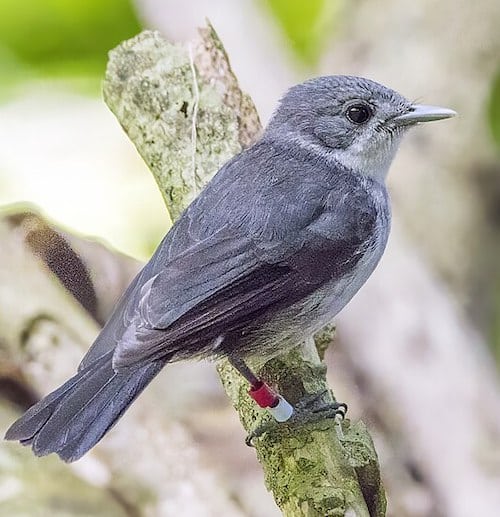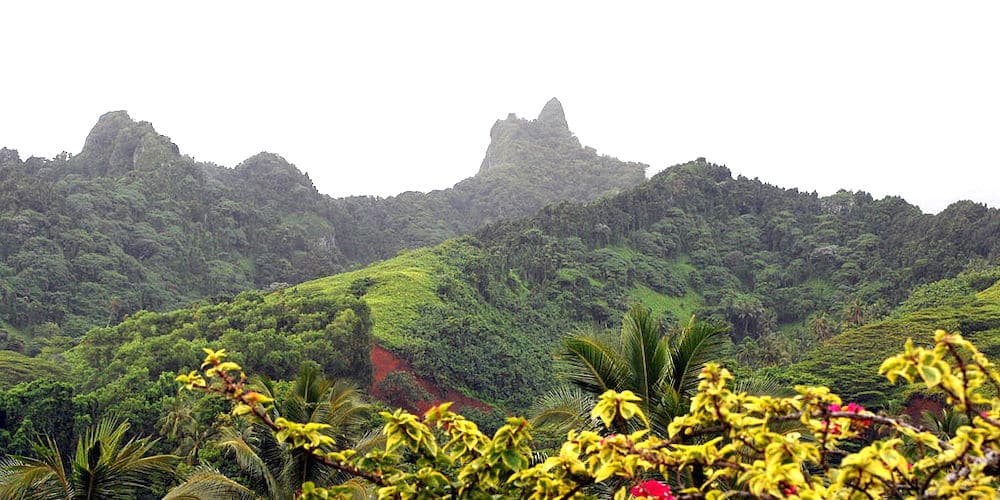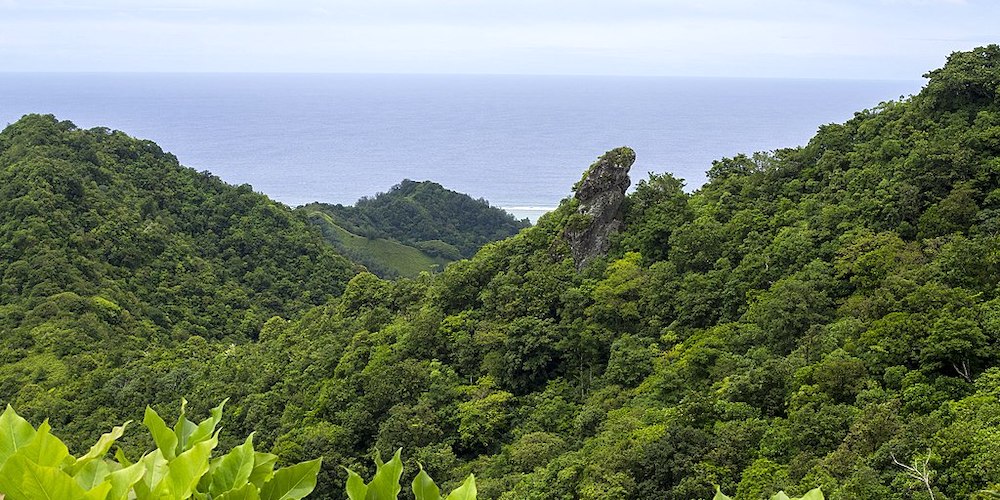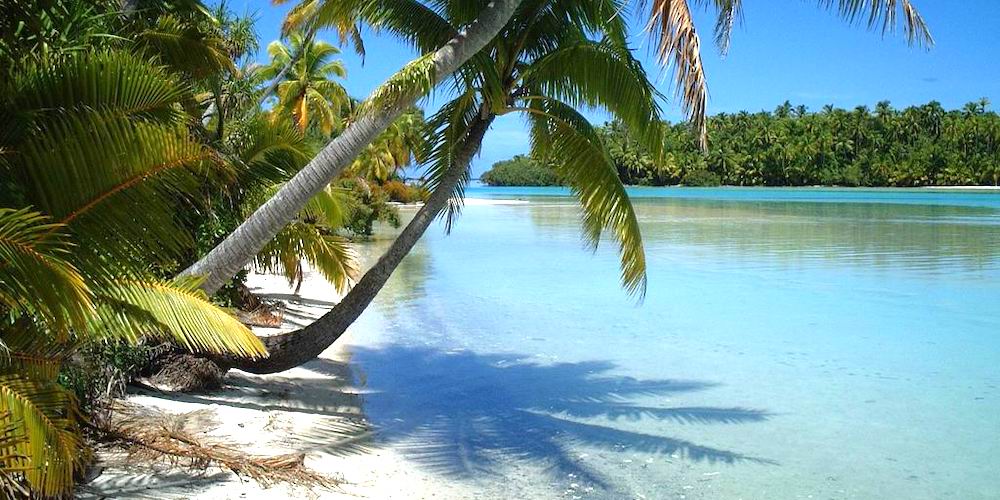Cook Islands

The Cook Islands is an island country in Polynesia, part of Oceania in the South Pacific Ocean. It consists of 15 islands and two reefs, whose total land area is approximately just under 237 km2 (c. 90 square miles). However, they are scattered across over 1,960,000 km2 (almost 757,000 square miles) of ocean; an area almost as big as the whole of western Europe, but with a population of less than 16,000 people! Most people also have New Zealand citizenship, as the Cook Islands is self-governing while in free association with New Zealand. Avarua is its capital on the island of Rarotonga which also has an airport. There are around 80,000 Cook Islanders in New Zealand and around 28,000 in Australia. The fifteen islands divide socially and physically into a Northern Group of six islands and a Southern Group of nine islands. The five atolls and one sand-cay of the Northern Group, support extensive Coconut Palm plantations for copra.
The islands were formed by volcanic activity; the northern group is older and consists of six atolls, which are sunken volcanoes topped by coral growth. The climate is moderate to tropical. Two terrestrial ecoregions lie within the islands’ territory: the Central Polynesian tropical moist forests and the Cook Islands tropical moist forests.

Cook Islands Tropical Moist Forest – ©Jerrye & Roy Klotz MD, CC BY-SA 3.0 via Wikimedia Commons
Birding the Cook Islands
Unfortunately, The Cook Islands have a large non-native population of ship rat and kiore toka (Polynesian rat). The rats have dramatically reduced the bird population on the islands. The only resident landbird is the Pacific Pigeon (Rupe), which lives on three atolls, feeding mainly on the fruits of the indigenous Guettarda speciosa (‘Ano). Recently, Kuhl’s Lorikeets were re-introduced to Atiu from Rimatara.
The most important avian-island in the Northern Group is the uninhabited atoll of Suwarrow, which is a national park. Its reef-islets, a mere 1.6 km², support regionally significant colonies of Sooty Terns (100,000 pairs), Lesser Frigatebirds (5,000 pairs), Red-footed Boobies (1,000 pairs), Red-tailed Tropicbirds (500 pairs), and locally significant colonies of Great Frigatebirds (200 pairs), Brown Boobies (100 pairs) and Masked Boobies (10 pairs).
The other special seabird-island is Takûtea, an uninhabited sand-cay (1.2km²) in the Southern Group. Its traditional owners, the people of ‘Âtiu, have maintained Takûtea as a wildlife sanctuary since early this century. It has the country’s largest colony of Red-tailed Tropicbirds (1,500 pairs), and the only Southern Group colonies of Great Frigatebirds (100 pairs), Red-footed Boobies (100 pairs) and Brown Boobies (20 pairs). Takûtea is also a regionally important wintering site for the Bristle-thighed Curlew, an Alaskan migrant listed as ‘Vulnerable’.

Rugged Rarotonga – ©Sleeps-Darkly, CC0, via Wikimedia Commons
The Southern Group, with 90% of the land and 90% of the population, is physically diverse with a young volcanic island (Rarotonga), four raised-reef islands (Mangaia, ‘Âtiu, Ma‘uke and Miti‘âro), an almost-atoll (Aitutaki), two atolls (Manuae and Palmerston) and a sand-cay (Takûtea). Rarotonga, the commercial and administrative centre of the country, is the largest (67km²), highest (653m) and most populated (10,000) island. The inhabitants live on narrow, coastal lowland with a highly-modified vegetation, while the mountainous interior is a near-pristine tropical forest supporting three endemic land birds.
The Southern Group, which includes Endemic Bird Area F29, supports eleven indigenous, non-migratory land birds. These include: four single-island endemics (Rarotonga Flycatcher, Rarotonga Starling, Atiu Swiftlet and Mangaia Kingfisher); two two-island endemics (Cook Islands Fruit-Dove and Cook Islands Reed-Warbler); and seven multi-island non-endemics (Grey Duck, Reef-Heron, Pacific Fruit-Pigeon, Spotless Crake and Chattering Kingfisher). Only three introduced land birds have naturalised: Red Junglefowl, Blue Lorikeet, and Common Myna.
The birds of special international interest are the six endemic land birds, which are all listed as ‘Vulnerable’ or ‘Critically Endangered’. The other bird of special international interest is the introduced Blue Lorikeet, which is endemic to neighbouring French Polynesia, where it has decreased its indigenous range from more than 20 islands at the turn of the century to six islands.
The single ‘Critically Endangered’ species, and now the most well-known Cook Islands bird, is the Rarotonga Flycatcher (Kâkerôri), or Rarotonga Monarch. In 1885 a naturalist recorded that the flycatcher, which had formerly been abundant everywhere on the island, had undergone a serious decline and was almost extinct. Nearly a hundred years later, in the first national bird survey of 1972, British ornithologist David Holyoak saw two, heard three, and estimated the population at one or two dozen pairs. In 1983, British ornithologist David Todd reported 21 birds, and two nests, in the headwaters of adjacent valleys on the south side of the island. In the spring of 1987, New Zealanders Rod Hay, Hugh Robertson and Gerald McCormack launched the Kâkerôri Recovery Programme, under the auspices of the Cook Islands Conservation Service, with volunteers from New Zealand, and financial support from the New Zealand Government and the South Pacific Regional Environment Programme (SPREP). As a result of this continued effort the number of Kākerōri had risen from the low of 29 to more than 132 at the start of the 1996 breeding season.
Mangaia, nearly the same size as Rarotonga, has eroded volcanic hills in the centre surrounded by a kilometre-wide limestone palisade – a raised-reef – reaching 60m elevation and supporting a healthy tropical forest. The fossil record shows that Mangaia had 13 resident land birds, of which only five have survived, including the Mangaia Kingfisher (Tanga‘eo), a single-island endemic. This rufous-collared kingfisher is treated as a separate species by some, although othwers have it as a subspecies of the more widespread Chattering Kingfisher.
During the early 1980s, residents of Mangaia were reporting that their kingfisher was declining in numbers, and they blamed the Common Myna, which was successfully introduced around 1960. From the 149 birds seen/heard, the estimated population was between 250 and 450 birds. It was concluded that the kingfishers bred more successfully in the dense Barringtonia patch-forests, and less successfully in open modified-forests where they were disturbed by the Myna.
‘Âtiu, another raised-reef island, has six indigenous resident land birds including the Atiu Swiftlet (Kôpeka), a single-island endemic. This swiftlet is unusual in using an audible clicking to navigate in the pitch-black interior of its breeding caves; the species are restricted to two caves, which supported only 190 nests.
The fourth single-island endemic frequently raising concern is the Rarotonga Starling (‘Αoi), which is restricted to the rugged inland of Rarotonga. Although this species has not been quantitatively surveyed, it is widespread throughout the inland. However, because they occupy relatively large territories, their total number may be relatively low, in the vicinity of 500 birds. The two two-island endemics, the Cook Islands Fruit-Dove (Kûkupa) and Cook Islands Reed-Warbler (Kereârako), are relatively common. The fruit-dove is common on Rarotonga and ‘Âtiu, while the reed-warbler is common on Mangaia and Miti‘âro.

Southern Cook Islands – Public domain, via Wikimedia Commons
The last resident land bird of special international interest is the Blue Lorikeet (Kurâmo‘o) on the almost-atoll of Aitutaki. (Fossil evidence from several islands show that the indigenous lorikeet of the Southern Cooks was the Rimatara Lorikeet (Kura) extirpation from the Cook Islands sometime prior to the arrival of European settlers in the 1820s.) The first mention of the Blue Lorikeet on Aitutaki was in 1899 when it was referred to as the pet of the natives. Presumably it arrived as a cage-bird in the early 1800s on one of the many sailing ships from French Polynesia, where the species was still widespread. The Blue Lorikeet population has been surveyed several times with estimates of the total population typically ranging from about 1200 bird.
The present indigenous land birds of the Cook Islands are those that survived the two massive environmental upheavals: the arrival of the Polynesians about 2,000 years ago, and the arrival of Europeans since the 1820s. However, provided the Ship Rat (and maybe the Myna) can be controlled, the prognosis for their continued survival is very good.
-
Suwarrow National Park
WebsiteSatellite ViewThe most southern atoll of the Northern Cooks - Suwarrow Island. The island is one of the most important sea-bird breeding areas in the South Pacific.
-
Number of bird species: 91
(As at December 2024)
Number of endemics: 6
Cook Islands Fruit-Dove Ptilinopus rarotongensis
Rarotonga (Monarch) Flycatcher Pomarea dimidiata
Cook Islands (Reed-)Warbler Acrocephalus kerearako
Rarotonga Starling Aplonis cinerascens
Atiu Swiftlet Collocalia sawtelli
Mangaia (Mewing) Kingfisher Todirhamphus ruficollaris
-
Avibase
PDF ChecklistThis checklist includes all bird species found in Cook Islands , based on the best information available at this time. It is based on a wide variety of sources that I collated over many years. I am pleased to offer these checklists as a service to birdwatchers. If you find any error, please do not hesitate to report them. -
Wikipedia
Annotated ListThis is a list of the bird species recorded in the Cook Islands. The avifauna of the Cook Islands include a total of 88 species, of which 7 are endemic and 3 have been introduced by humans. -
eBird
PDF ChecklistThis checklist is generated with data from eBird (ebird.org), a global database of bird sightings from birders like you. If you enjoy this checklist, please consider contributing your sightings to eBird. It is 100% free to take part, and your observations will help support birders, researchers, and conservationists worldwide.
-
Birds of Eastern Polynesia: A Biogeographic Atlas
| By Jean-Claude Thibault & Alice Cibois | Lynx Edicions | 2017 | Hardback | 438 pages, 200 colour photos and illustrations, 70 b/w illustrations, 142 colour distribution maps | ISBN: 9788416728053 Buy this book from NHBS.com -
The Birds of Hawaii and the Tropical Pacific
| By H Douglas Pratt, Phillip L Bruner & Delwyn G Berrett | Princeton University Press | 1992 | Paperback | 409 pages, 45 plates with colour illustrations; 48 b/w illustrations, 14 maps | ISBN: 9780691023991 Buy this book from NHBS.com
-
Terrestrial Protected Areas
WebpageSatellite ViewThere are 14 terrestrial PAs, which total at least 1407.2 hectares (five PAs are uncalculated), or about six per cent of the Cook Islands’ total 240 km2 land mass. Terrestrial PA are concentrated in a few locations. -
The Takitumu Conservation Area
WebpageSatellite ViewThe TCA is a 155 ha forested area situated within the Takitumu district on the south eastern side of inland Rarotonga. It is the core breeding area of the (no longer) endangered and unique landbird – the kakerori, Rarotonga Fly-catcher. The area was mainly established to protect the kakerori but also to conserve many other unique plants and animals found there.
-
BirdQuest
Tour OperatorCook Islands Tours -
Birdman George
Local Tour OperatorI'm George Mateariki your Eco Tour guide on Atiu. I will pick you up in my bush van and take you around the island explaining the history and lifestyle of the people and pointing out the fauna, local medicines and birds. I also include an optional bush trail following the historical Captain Cook trail. Tropical lunch provided. Specialist tours of Atiu's rare birds can also be booked in advance and includes the opportunity to spot the rare kakeori and kopeka birds -
Sanctuary Rarotonga
Local Tour OperatorThe Cook Islands offers bird lovers the chance to view some beautiful birdlife, including at least 6 which are only found here...
-
2017 [11 November] - Pete Morris - French Polynesia & the Cook Islands
PDF ReportIt has to be said, this was not a tour for those that are after a long bird list, with just 80 species recorded, including those seen on the extension. However, the quality was high, with no fewer than 50 diamond birds being recorded – an amazingly high percentage of special birds! The first part of this tour focused on various island groups in French Polynesia. Beginning on Tahiti and Moorea (where we easily found our target endemics). -
2022 [03 March] - Ledzep
Report...Probably the next most common bird to be seen around the island are the WHITE TERN, both at sea, and in trees (especially the Silk Tree) on the mainland. The RAROTONGA FRUIT DOVE (Lilac Crowned Fruit Dove) is less numerous, but we saw them frequently around most areas of the island...
-
Cook Islands Natural Heritage Trust
WebsiteThe Cook Islands has only a few species of birds although there are six unique species found nowhere else in the world. These include the very rare Kakerori found only in the high forests on the south coast of Rarotonga and the low forests on Atiu… -
KiaOrana
WebsiteThe Cook Islands are made up of 15 distinct islands. Rarotonga is the capital island. The islands of the Cook group have a total land area of about 92 sq. miles, scattered over a vast 2 million square kilometre area of Pacific Ocean

